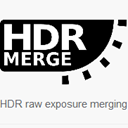HDRMerge Alternatives

HDRMerge
HDRMerge combines two or more raw images into a single raw with an extended dynamic range. It can import any raw image supported by LibRaw, and outputs a DNG 1.4 image with floating point data. The output raw is built from the less noisy pixels of the input, so that shadows maintain as much detail as possible. This tool also offers a GUI to remove ‘ghosts’ from the resulting image.
Wait… Another HDR program??
Not exactly… Common HDR programs, like Luminance HDR or Photomatix, actually perform two tasks:
Exposure merging.
Tone mapping.
Exposure merging consists in taking the best pixels of a set of images with different exposures and obtain an output image with a higher dynamic range than any of the inputs. This is what HDRMerge does. Tone mapping consists in squeezing an HDR image to present it with all its detail in low dynamic range devices, like screens or paper. Usually, as a result, shadows are pulled up and local contrast is enhanced.
Something that many people do not realize is that these two tasks are totally independent from each other. For instance, Luminance allows you to save the HDR image that results from the merging task. Then, you can load it (or any other HDR image) later to apply any tone mapping operator that Luminance implements. Likewise, HDRMerge generates an HDR image that can be later tone-mapped with another program.
So, why should I use HDRMerge?
https://jcelaya.github.io/hdrmerge/documentation/2014/05/24/what-is-hdrmerge.html
Best HDRMerge Alternatives for Linux
Are you trying to find the best programs like HDRMerge? Have a look at this post and weigh in on your thoughts. Cool!

Luminance HDR
FreeOpen SourceMacWindowsLinuxLuminance HDR is a graphical user interface (based on the Qt5 toolkit) that provides a complete workflow for HDR imaging.
HDRMerge Reviews
Add your reviews & share your experience when using HDRMerge to the world. Your opinion will be useful to others who are looking for the best HDRMerge alternatives.
Table of Contents